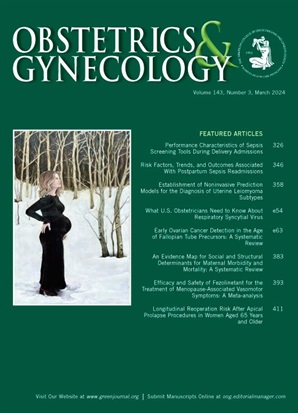一项基于人群的纵向数据集中孕产妇死亡与婴儿结局的关系
IF 4.7
2区 医学
Q1 OBSTETRICS & GYNECOLOGY
引用次数: 0
摘要
目的评估妊娠相关死亡或严重孕产妇发病率与婴儿结局之间的关系。方法:我们使用1999年至2021年马萨诸塞州的数据进行了一项回顾性队列研究。该数据集包括与出生和母婴死亡记录纵向相关的医院记录。主要暴露是妊娠相关死亡(妊娠期间或产后一年的死亡)、严重孕产妇发病率以及严重孕产妇发病率后的妊娠相关死亡。主要结果是第一年婴儿死亡,存活婴儿在出生后第一年住院。双变量和稳健泊松回归分析通过广义估计方程回归来估计暴露与结果之间的关系。结果1999年至2020年间,马萨诸塞州1617054例活产婴儿中,有474例与妊娠相关的死亡。40岁以上(49.3/10万)、非西班牙裔黑人(40.3 /10万)、有公共保险(51.1/10万)或产胎4次或以上(80.6/10万)的人与妊娠相关的死亡率最高。在经历严重孕产妇发病率(745.3/100,000)的个体中,与阿片类药物使用相关的医院就诊(721.2/100,000)或有记录的妊娠前共病(200.7/100,000)的妊娠相关死亡率最高。在妊娠相关死亡病例中,每1000例活产婴儿死亡率为55.0 (95% CI, 34.9-75.2),而母亲存活的婴儿死亡率为4.0 (95% CI, 3.9-4.1)。当妊娠相关死亡伴随着严重的孕产妇发病时,婴儿死亡率为每1,000活产87.9例(95% CI, 29.7-146.1)。在妊娠相关死亡后,当一个足月婴儿存活到1岁时,在出生后第一年再住院的可能性比母亲未死亡时高35%(校正风险比1.35,95% CI, 1.01-1.82)。结论妊娠相关死亡与婴儿死亡和出生后1年内幸存儿童健康状况恶化相关,进一步证明了孕产妇死亡的深远影响以及母婴健康之间的明确联系。本文章由计算机程序翻译,如有差异,请以英文原文为准。
Relationship Between Maternal Death and Infant Outcomes in a Longitudinal, Population-Based Dataset.
OBJECTIVE
To estimate the association between pregnancy-associated death or severe maternal morbidity and infant outcomes.
METHODS
We conducted a retrospective cohort study using Massachusetts statewide data from 1999 to 2021. The dataset included hospital records longitudinally linked to births and maternal and infant death records. The primary exposures were pregnancy-associated death (deaths during pregnancy or in the year postpartum), severe maternal morbidity, and pregnancy-associated death after severe maternal morbidity. The main outcomes were infant death in the first year and, for those infants who survived, hospitalization in the first year of life. Bivariate and robust Poisson regression analyses through generalized estimating equations regression were used to estimate the association between the exposures and outcomes.
RESULTS
Of 1,617,054 live births in Massachusetts between 1999 and 2020, there were 474 pregnancy-associated deaths. Pregnancy-associated death ratios were highest among individuals who were aged 40 years or older (49.3/100,000), who were non-Hispanic Black (43.0/100,000), who had public insurance (51.1/100,000), or who had a parity of four or more (80.6/100,000). Among individuals experiencing severe maternal morbidity (745.3/100,000), those who had a hospital encounter associated with opioid use (721.2/100,000) or a documented prepregnancy comorbidity (200.7/100,000) had the highest pregnancy-associated death ratios. In cases of pregnancy-associated death, the infant mortality rate per 1,000 live births was 55.0 (95% CI, 34.9-75.2) compared with 4.0 (95% CI, 3.9-4.1) when the mother survived. When the pregnancy-associated death followed severe maternal morbidity, the infant mortality rate was 87.9 per 1,000 live births (95% CI, 29.7-146.1). After a pregnancy-associated death, when a full-term infant survived to 1 year of age, there was a 35% greater likelihood of rehospitalization in the first year of life (adjusted risk ratio 1.35, 95% CI, 1.01-1.82) than when the mother did not die.
CONCLUSION
Pregnancy-associated death was associated with infant death and worse health of surviving children in the first year of life, further demonstrating the far-reaching consequences of maternal deaths and the clear link between maternal and infant health.
求助全文
通过发布文献求助,成功后即可免费获取论文全文。
去求助
来源期刊

Obstetrics and gynecology
医学-妇产科学
CiteScore
11.10
自引率
4.20%
发文量
867
审稿时长
1 months
期刊介绍:
"Obstetrics & Gynecology," affectionately known as "The Green Journal," is the official publication of the American College of Obstetricians and Gynecologists (ACOG). Since its inception in 1953, the journal has been dedicated to advancing the clinical practice of obstetrics and gynecology, as well as related fields. The journal's mission is to promote excellence in these areas by publishing a diverse range of articles that cover translational and clinical topics.
"Obstetrics & Gynecology" provides a platform for the dissemination of evidence-based research, clinical guidelines, and expert opinions that are essential for the continuous improvement of women's health care. The journal's content is designed to inform and educate obstetricians, gynecologists, and other healthcare professionals, ensuring that they stay abreast of the latest developments and best practices in their field.
 求助内容:
求助内容: 应助结果提醒方式:
应助结果提醒方式:


